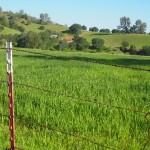
We are nowhere near set up to make our own hay yet – we are not growing much in the way of mowable grass, we have no hay-making equipment, and the horses (and I) are not trained or fit enough for the task. While it remains a future goal to grow and put up our own hay on our property, for the next 5 years we need to buy it from others.
Each “animal unit” (a cow, a horse, 2 miniature donkeys, 5-6 sheep) consumes approximately 20-25 pounds of dry forage daily – or about 4 tons per year. Fresh forage is great, but plant growth cycles and weather conditions limit how many months the animals can get all their nutrition by grazing in pastures. Hay is made from grasses and other plants that are cut, dried and baled at the height of their nutrition and palatability. Grass-fed livestock rely on this for all their nutrition during the months that the pastures do not provide sufficient feed.
The cheapest way to buy good hay is straight out of the field, picking up a year’s worth of bales just a few days after they come out of the baler. This reduces the burden of labor and storage incurred by the seller, savings that are passed along to the buyer who is willing to buy a large amount up front, make the effort to get it home and has the space to store it. Fortunately, we live in an agricultural area with good quality hay and a strong market – as well as casual labor to help move bales that weigh about 100 pounds each. While we have not yet acquired any sheep or cattle, we do have to plan for our 3 horses.
Other approaches to buying hay are to buy truckloads shipped in from other areas or to buy smaller amounts at regular intervals. Unfortunately, the price per bale goes up considerably when buying fewer bales and when transporting them great distances. Compounding the hay economy further are the drought conditions in California and the southwestern states. Farmers who often can cut hay from the same field 5 or 6 times in a year do not expect to have the water to make more than one cutting this year. Uncertainty about water availability – either through rainfall or irrigation – leads to one certainty: hay prices are going to be very high this year in California.
As hay prices rise and pastures dry up, cattle and sheep are likely to go to slaughter a little earlier than usual – and those smaller animals will yield less meat (and profit) although the growing global demand for meat should offset any price drops caused by the increased number of animals going to slaughter. However, ranchers who have spent years or decades developing their breeding stock and improving herds will face very hard decisions about which and how many animals to sell and horse owners will need to spend more than ever on hay, as scarcity of hay drives prices higher.

Interesting, Mary! I’m so glad to have discovered your farm’s blog. I’m following along.